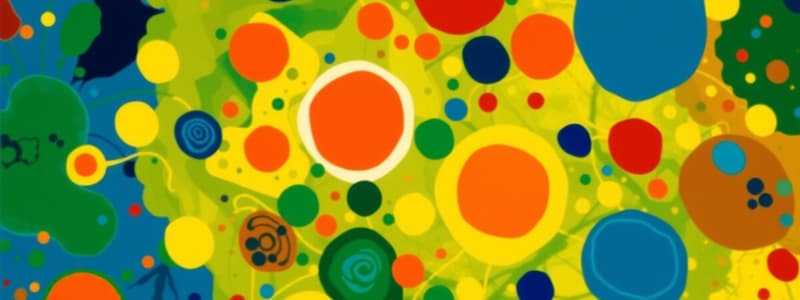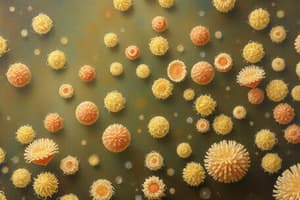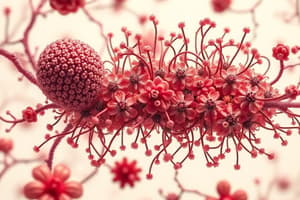Podcast
Questions and Answers
Which is the most correct scientific name?
Which is the most correct scientific name?
- Baker's yeast
- Saccharomyces Cerevisiae (correct)
- Saccharomyces Cerevisiae (correct)
- S.Cerevisiae
- All of the above are correct
Eukarya includes all of the following except:
Eukarya includes all of the following except:
- Animals
- Viruses (correct)
- Plants
- Fungi
- Protists
In 1978, Carl Woese devised a system of classification that groups organisms into the domains; bacteria, archaea and ____________.
In 1978, Carl Woese devised a system of classification that groups organisms into the domains; bacteria, archaea and ____________.
Eukarya
Microorganisms are involved in each of the following processes EXCEPT:
Microorganisms are involved in each of the following processes EXCEPT:
Each of the following organisms would be considered a microbe EXCEPT:
Each of the following organisms would be considered a microbe EXCEPT:
The term used to describe a disease-causing microorganism is:
The term used to describe a disease-causing microorganism is:
Common commercial benefits of microorganisms include synthesis of:
Common commercial benefits of microorganisms include synthesis of:
Commercial utilization of microbial products has become increasingly popular due to their environmentally friendly nature. Production of these products which are readily degraded and, thus, non-toxic typically utilizes:
Commercial utilization of microbial products has become increasingly popular due to their environmentally friendly nature. Production of these products which are readily degraded and, thus, non-toxic typically utilizes:
The formal system for classifying and naming organisms was developed by:
The formal system for classifying and naming organisms was developed by:
In the name Staphylococcus aureus, aureus is the:
In the name Staphylococcus aureus, aureus is the:
A prokaryotic cell may possess each of the following cellular components EXCEPT:
A prokaryotic cell may possess each of the following cellular components EXCEPT:
Which of the following is NOT associated with viruses?
Which of the following is NOT associated with viruses?
The bacterial shape of the cells in the scanning electron micrograph (Rod-shaped) shown in Figure 1.1 would best be described as:
The bacterial shape of the cells in the scanning electron micrograph (Rod-shaped) shown in Figure 1.1 would best be described as:
Protozoan motility structures include:
Protozoan motility structures include:
Viruses are not considered living organisms because they:
Viruses are not considered living organisms because they:
The infectious agent that causes AIDS is a:
The infectious agent that causes AIDS is a:
Which of the following is NOT a domain in the three-domain system?
Which of the following is NOT a domain in the three-domain system?
Classification of organisms into three domains is based on:
Classification of organisms into three domains is based on:
Archaea differ from bacteria in that archaea:
Archaea differ from bacteria in that archaea:
Who is credited with first observing cells?
Who is credited with first observing cells?
Who is credited with first observing microorganisms?
Who is credited with first observing microorganisms?
Biogenesis refers to the ____________.
Biogenesis refers to the ____________.
Flashcards are hidden until you start studying
Study Notes
Microbiology Basics
- The most correct scientific name for Baker's yeast is Saccharomyces cerevisiae.
- Eukarya does not include viruses; it encompasses protists, fungi, plants, and animals.
- Carl Woese's classification system identifies three domains: bacteria, archaea, and Eukarya.
Microorganisms and Their Functions
- Microorganisms play crucial roles in infection, decomposition, and O2 production, but they do not contribute to smog production.
- Common microbes include yeast, protozoa, bacteria, and viruses; mushrooms are not classified as microbes.
- A pathogen is defined as a disease-causing microorganism.
Commercial Benefits of Microbes
- Microorganisms are used commercially for the synthesis of riboflavin, acetone, and insulin.
- The environmentally friendly production of microbial products typically utilizes enzymes.
Classification and Naming
- Carolus Linnaeus established the formal system of classifying and naming organisms.
- In Staphylococcus aureus, "aureus" represents the specific name, distinguishing it from the genus.
Cell Structures and Viruses
- Prokaryotic cells lack a nucleus but may have flagella, ribosomes, a cell wall, and a cell membrane.
- Organelles are not associated with viruses; they consist of nucleic acid, an envelope, chemical reactions, and a protein coat.
- Bacterial cells with rod shapes are classified as bacilli.
Protozoan Movement and Viruses
- Protozoans utilize cilia, flagella, and pseudopods for motility.
- Viruses are not considered living organisms due to their inability to reproduce independently.
Infectious Agents and Classification Domains
- The infectious agent responsible for AIDS is a virus.
- "Animalia" is not a domain in the three-domain system, which includes archaea, bacteria, and eukarya.
Cellular Characteristics
- The classification of organisms into three domains is based on cellular organization.
- Archaea differ from bacteria by having diverse cell wall compositions, despite both being prokaryotic.
Historical Figures in Microbiology
- Robert Hooke is credited with the first observation of cells.
- Anton van Leeuwenhoek is recognized for the discovery of microorganisms.
Studying That Suits You
Use AI to generate personalized quizzes and flashcards to suit your learning preferences.




